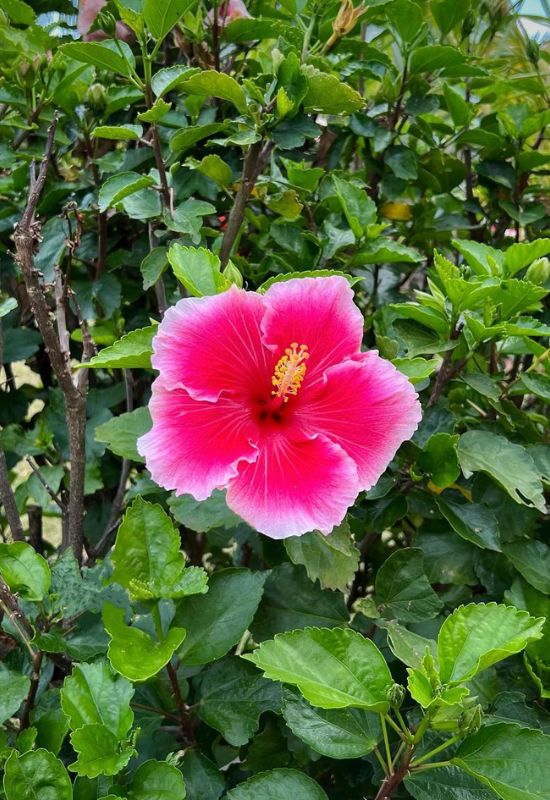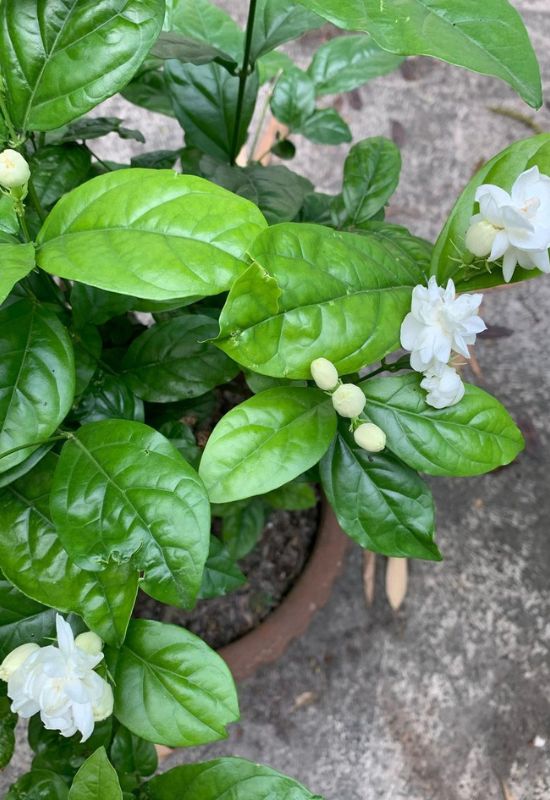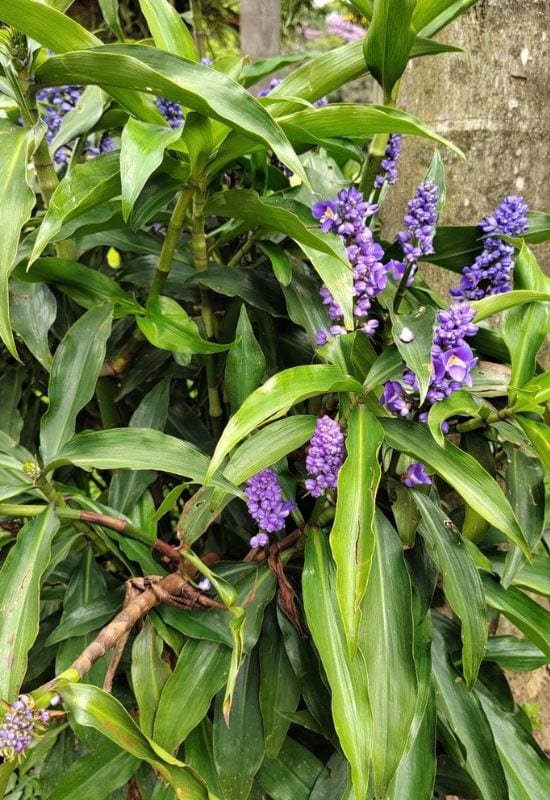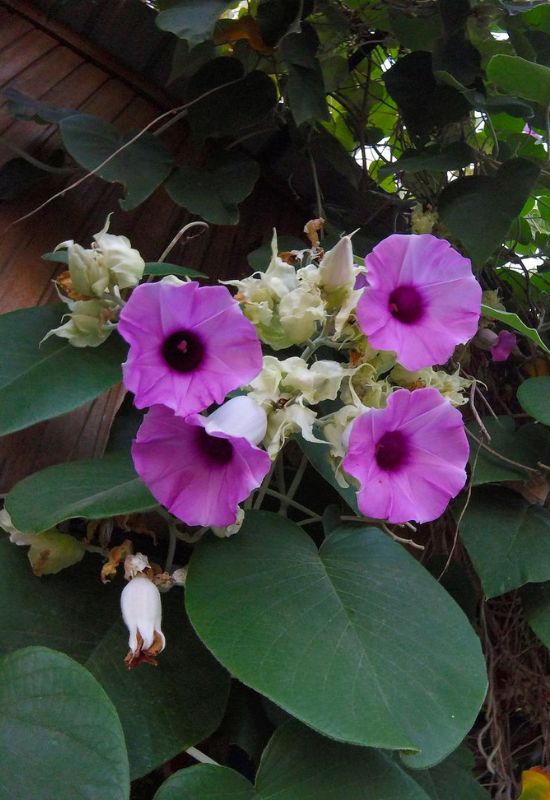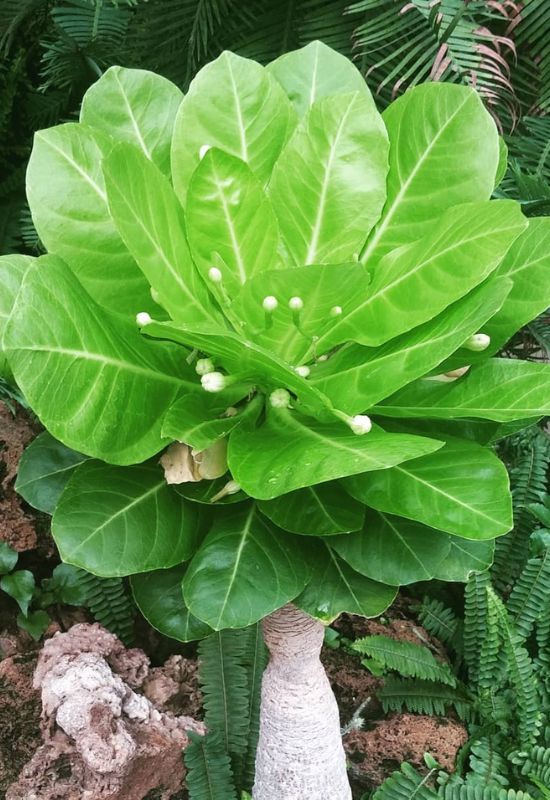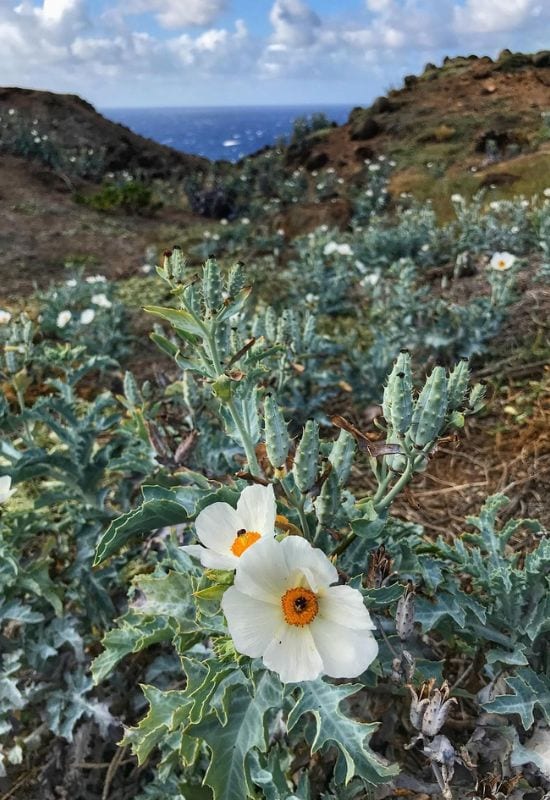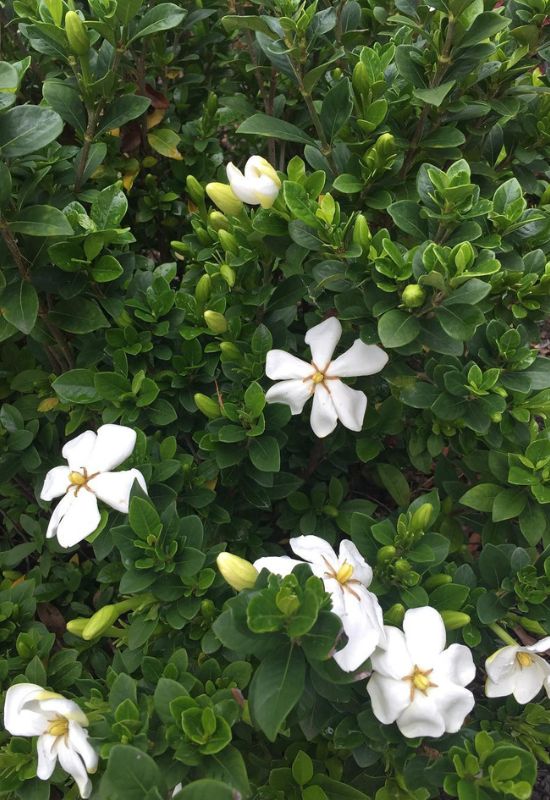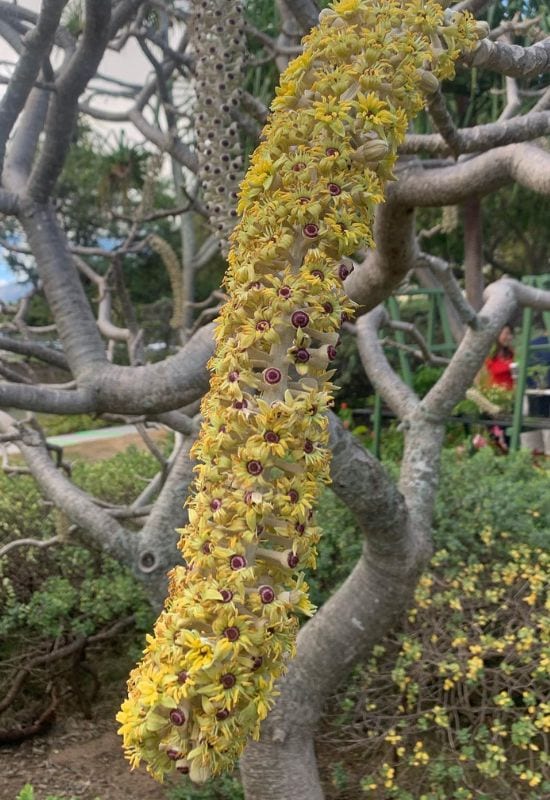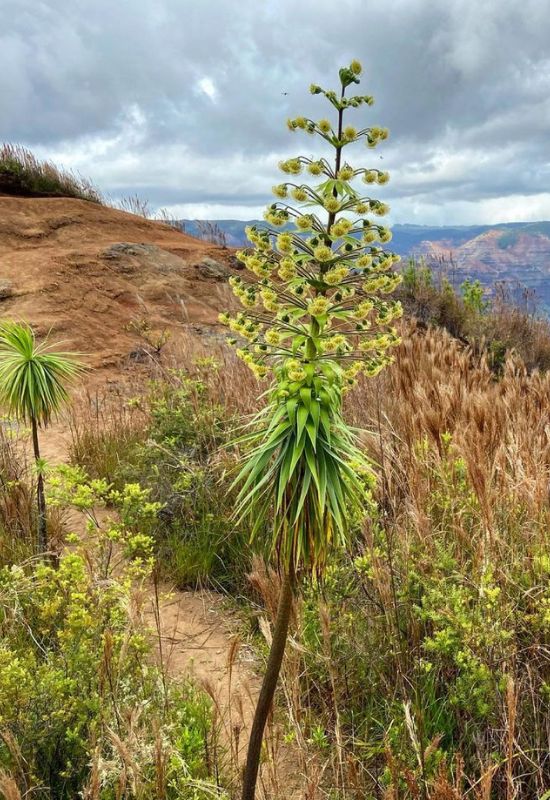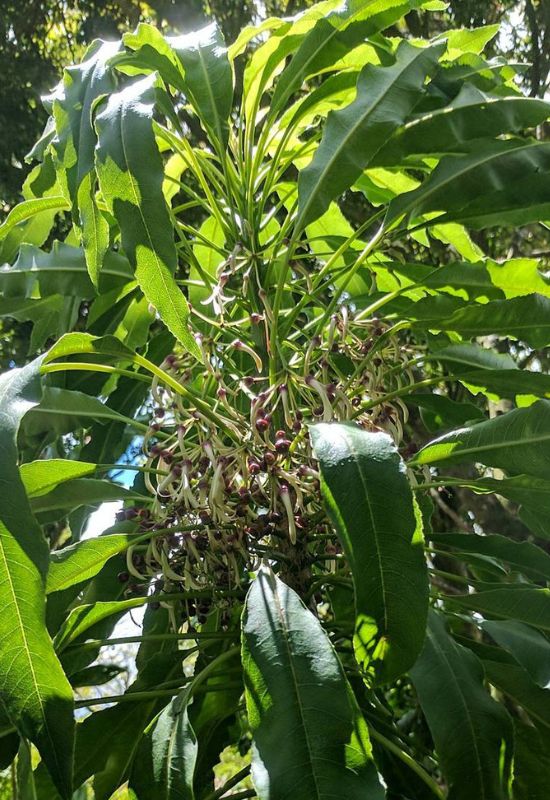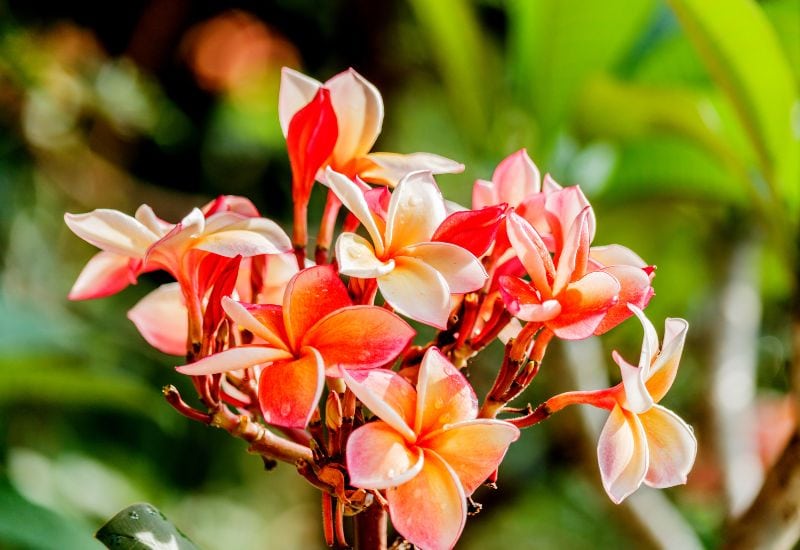
Think of Hawaii and what do you see in your mind? Bright sunlight, music, people with beaming smiles, volcanoes and – yes, flowers!
Colorful, exotic, full of energy and generous blooms are as much part of these Pacific islands as of the culture of their hospitable people!
And leis of fragrant blossoms are a symbol of this amazing archipelago, a sign of welcome, but also love, friendship and celebration – of life!
Some incredible flowering varieties are native of these Sun kissed islands of Hawaii, and they have found their ways into gardens worldwide, like hibiscus, the national flower. Others have come to the islands, and they have called them their home, becoming symbolic of the life force of this land and generosity of its people, like bird of paradise.
And the natural love Hawaiians have for flowers is clear when you set foot on their land, but also if you look at how many names they have given them in their own language, often with highly symbolic value.
If you live in a warm region and desire eye-catching, unusual blooms for your garden, Hawaii has a plethora of options to offer. This tropical paradise boasts some of the most stunning flowers in the world. Below, we have curated a selection of Hawaii’s most beloved, iconic, and prevalent floral varieties. Enjoy their exquisite beauty!
15 Exotic Hawaiian Flowers That Will Leave You in Awe
It is hard to pick only 15 varieties out of the many exotic looking flowers of these islands, but here they are!
And the first common Hawaiian flower you will meet is a real classic, but you will also see varieties that you have never heard of and can’t be found anywhere else…
1: Hibiscus (Hibiscus spp.)
Of course, the first spot belongs to the national flower of Hawaii, and worldwide garden favorite: hibiscus, or aloalo, or hauhele, as Hawaiians call it!
Its big, round and colorful blooms perfectly incapsulate the sunny, exotic and festive nature of these famous Pacific islands and their hospitable inhabitants.
With cultivars reaching a whopping 12 inches across (30 cm), they brighten up gardens with their reds, yellows, pinks, mauve and oranges, but also white ones are really stunning.
The long and protruding reproductive column in the middle with both stamens and pistils is an iconic trait of its showy summer blossoms, and very decorative in themselves.
Grown as shrubs or even small trees, they also offer lush serrated and almond shaped foliage for a fresh backdrop to its impressive floral displays.
The garden fortune of hibiscus is also due to its resilience and low maintenance, and with some cold hardy varieties, like rose of Sharon and rose mallow, you can have its Hawaiian beauty in your green space even in temperate regions, as a specimen plant, in hedges or even containers!
2: Bird of Paradise (Strelitzia reginae)
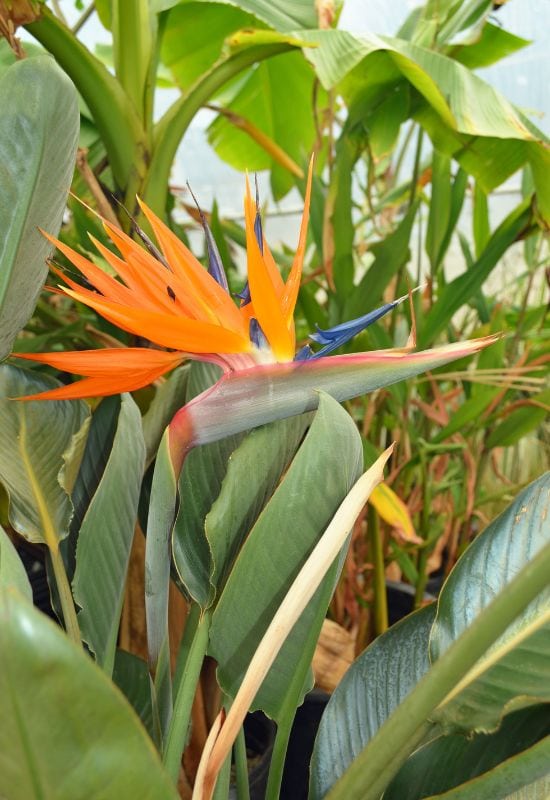
Puamanu, a.k.a. “little globe” in Hawaiian, is better known all over the world as bird of paradise, or with its official name, Strelitzia. It is not a native variety of the islands, from Africa, but it has naturalized and become very common since its introduction in about 1940.
Its impressive flowers give it its name, because they look like colorful wings, with super bright orange, blue and some touches of red and even purple. They are hold in iconic boat shaped bracts, which bring us back to the maritime theme of the Pacific Ocean.
Long lasting and big, up to 12 inches, or a mind blowing 20 inches (50 cm) in its white sister, Strelitzia nicolai! This exotic floral display lasts for months on end, from May to December, and it is a magnet for humming birds because they blossoms are literally packed with sweet nectar.
The evergreen leaves are leathery to rubber like, broadly elliptical to ovate, and they too are massive, tropical and super glossy, in colors between dark and pale green, sometimes with bluish hues and purplish ribs!
Winner of the Award of Garden Merit by the Royal Horticultural Society, bird of paradise is one of the most exotic perennials in the world, for large borders or as a specimen plant, and it is also an outstanding cut flower. However, it is easy to grow from its underground rhizome.
3: Arabian Jasmine (Jasminum sambac)
A wonderful climbing perennial that has found its home in Hawaii is Arabian jasmine, native of tropical Asia but really at ease and widespread on the islands.
In fact, their inhabitants have given it their own name, pikake, translated as peacock, and used to make the famous Hawaiian lei (wreath of flowers). Used to flavor green tea, it starts its bloom in early spring with fragrant white blossoms, in clusters of 3 to 12, each about 1 inch across (2.5 cm) and with a waxy texture.
They will later blush to pink as they mature, giving you a changing display. Appearing here and there on the lush evergreen foliage, they will last till the end of the season.
However, if you are lucky and your garden is in a warm country, these snow colored stars could well pop up all year round. Very glossy and born bright green with copper overtones, the ellipticalleaves mature to deep shade of emerald.
This twining beauty too has won the Award of Garden Merit by the Royal Horticultural Society, and it’s no surprise
Arabian jasmine is a wonderful climber to grow on string structures, like sturdy trellises or gates and walls. You can also have it in containers to shelter it over winter.
4: Hawaiian Blue Ginger (Dichorisandra thyrsiflora)
Fully native of Hawaii, blue ginger, a.k.a. ahwapuhi, is not actually a ginger variety, but a tropical woodland perennial related to Tradescantia, and a beauty to behold!
As the name suggests, the blossoms are super vibrant sapphire blue, sometimes with some violet in them, with three waxy and rounded petals partly joined, but with a white dividing stripe between them, and usually cream to golden yellow reproductive organs.
They come on long and upright purple stems, in clusters, technically in panicles, that bring this exotic bloom up to eye level, as it can grow to a considerable 8 feet tall (1.8 meters)! But wait, this is not all…
The floral display will start in February and it will keep going with repeated spectacles all the way to the end of fall! It only takes a little break in the height of winter!
The long and wavy, deep green and glossy leaves behave differently; they are almost prostrate, forming a beautiful basal rosette!
Winner of the Award of Garden Merit by the Royal Horticultural Society, Hawaiian blue ginger is not an easy plant to find, but if you do, there’s hardly a better choice for an exotic flowering beauty with an almost electric blue bloom like this!
5: Hawaiian Baby Woodrose (Argyreia nervosa)
A “naughty adoptive child” of Hawaii, Hawaiian baby woodrose, or pilikai, also known as elephant creeper, is a morning glory variety native of India, but it has found a perfect habitat on the Pacific islands, from which it takes its name.
It has the classical funnel shaped blooms we meet in Ipomoea varieties, about 2 inches across (5.0 cm) and 3 in length (7.5 cm). They have a beautiful lavender pink shade and a maroon center.
They start their enchanting blossoms in mid summer and they will produce new ones regularly up to the beginning of fall, opening from candid white and soft looking buds.
It is a climber with thin and elegant vines and the large heart shaped leaves, semi glossy and mid to dark green, grow to 6 to 10 inches long (15 to 25 cm).
But the under page is silvery and hairy. The name comes from the seed pods, which look like roses when they open. But there is more to say about the seeds: they are highly hallucinogenic, and this plant is important in Ayurveda.
A highly decorative and exotic vine, Hawaiian baby wood rose is a very special plant indeed; some say it opens the doors to the spiritual world, but it can also grace your fence, trellis or pergola with its lush foliage and mesmerizing blooms.
6: ‘Aka ‘Aka ‘Awa (Hillebrandia sandwicensis)
As you may have guessed ‘aka ‘aka ‘awais a native Hawaiian flowering perennial, with another name too, pu’amakanui. While it is common in Hawaii, it is at risk in botanical and nature preservation terms, and it may not strike you as very unusual.
In fact, it looks very much like a begonia, and in fact it is related to it. With little clusters of nodding flowers, white with pink blushes, this indigenous species has a lovely tuft of golden pistils in the middle of make flowers and sculptural stamens in females ones, and the pedicle leads you up to bracts that give you a frilly and complex looking bloom altogether.
They will blossom from February to June, and then produce green fruit capsules, usually with three lobes. When they ripen, the plant dries back into the tubers. The foliage is broad, waxy and glossy, of a rich green color and with an unusual palmate shape.
‘Aka ‘aka ‘awa is one of the oldest species native of the Hawaii, in fact it is believed to be up to 65 million years old, and it came to the islands when they rose from the sea, 30 million years ago!
It is common in its habitat, but it likes high altitudes between 3,000 and 6,000 feet above sea level (900 to 1,800 meters), and it is small a small area. If you can find it, growing it may help with its preservation.
7: Frangipani (Plumeria spp.)

Well known all over the world, frangipani is native of tropical American regions, and a typical flower of Hawaii, where they call it melia. This small or medium sized exotic tree is a real wonder for sun bathed and warm gardens!
The five thick and oval petals that overlap partly like in a sculptural star form flowers that are about 3 to 3.3 inches across (7.5 to 8.0 cm) in small clusters. Used in leis, they can be white, yellow, orange, pink or red, and they are often bicolor.
With an amazing and strong fragrance, they are marathon bloomers as well, starting in late spring and coming again and again till fall! For an astounding cultivar, ‘Nebel’s Rainbow’ is mind blowing, true to its name, with white, orange, yellow and pink! The elongated, oval, leathery and glossy leaves are a real wonder too, reaching 13 inches in length (32.5 cm).
A real garden jewel, frangipani, or Plumeria is one of the most exotic looking plants that really express the sunny and colorful beauty of the Hawaiian islands and their people. It’s like happiness in a tree! And it is ideal for a coastal garden too!
8: Vulcan Palm (Brighamia insignis)
Vulcan palm is a classic of our Pacific islands (Hawaii means “homeland”) and it has a few names… Oluluor also alula is how natives call it, but the mist interesting of all is cabbage on a stick!
Yes, because it looks like one! This is due to the large rosettes of bright and fleshy leaves it has at the very top, evergreen and very sculptural indeed! Each is 5 to 8 inches in length (12.5 to 20 cm) and 2.5 to 4.5 inches wide (6.5 to 11.5 cm).
They are veined and they look a bit like those of pak choi but more plump! And you can get a few of these rosettes on each succulent trunk, which bulges into a bulbous shape at the bottom and tapers as you go up…
It will bloom between September and October with white or yellow fragrant flowers. The petals are fused into a tube up to 5.5 inches long (14 cm) and they open to a star at the mouth.
Vulcan palm is a very common garden and houseplant variety in Hawaii and beyond, and its beauty makes it ideal as a specimen plant in an exotic garden. Sadly, though, it is almost extinct in the wild: there are only a maximum of 65 individuals left. One more reason to grow it!
9: Hawaiian Poppy (Argemone blanca)
Hawaiian poppy is a real superhero of the flora of Hawaii, in the archipelago of volcanoes, in fact, it can survive fire! Native of this sunny land, called pua kala on the islands, it is a perennial and member of the Papaveraceae family, with white flowers that do look like the more common red ones we find in wheat fields.
And like its other, more infamous relative, it is used as a narcotic. Its yellow sap in fact makes you sleep, but its prickly and harsh looking foliage will certainly keep you awake. But its blooms are what really make this wild species very special…
With their many golden filaments at the center and candid, frail looking blossoms, it can keep your garden alight with beauty from January to… December!
And the woody, chalice shaped seed pods that follow can be a point of interest in flower beds of good cut dry flowers.
Hawaiian poppy is more herbarium variety, grown in botanical gardens and, of course, endemic on the islands of Hawaii.
As a decorative variety, it is suitable for wild looking designs; in desert and rock gardens, in fact, it will be a great all year round asset for natural looking floral displays. It is also ideal for xariscaping and if you are a collector of unusual plants.
10: Hawaiian Gardenia (Gardenia brighamii)
Similar to and related to more common garden varieties, Hawaiian gardenia is a native of these beautiful islands, quite big in some respects, not so in others… Let’s see…
The shrub can grow quite tall, up to 12 feet (3.6 meters) but it has a very small name for locals: na’u. This means a lot of very glossy and fleshy, waxy looking ovate leaves of wonderfully vibrant shades of green, with decorative and regular veins in them in a fishbone pattern, and it will give you this fresh and exotic charm all year round, being evergreen.
Its candid snow white flowers, with partly joined petals that open to soft looking blossoms at the mouth, 2 inches wide (5.0 cm) are fragrant and they will bloom at unusual times…
It is triggered by rainfall, and it will usually give you its floral display from March to May, then again in July, then again in December! The round fruits that follow are quite attractive too, and when they ripen, they take on whitish spots.
Hawaiian gardenia is a real classic of this beautiful land, but it is not very easy to obtain; here is another collector’s item for you, and an endangered though much loved species.
While it is not easy to grow, its blooms in the mid of winter, and super beautiful foliage are a real asset! And it is very long lived, up to 65 years.
11: False ‘Ohe (Polyscias racemosa)
False ‘ohe takes its name from a sister species, ‘ohe ‘ohe, or Polysciasbisattenuata, another native of Hawaii, but we picked this variety because it is more beautiful. And you will realize it when you see its long and dropping racemes fill with flowers in summer.
They can reach 2 feet long (60 cm) and they are packed with up to 250 blossoms each, that start opening from the bottom then climb up towards the branch.
They look a bit like passion flowers, with a purple center and cream white filaments all around that ripen to a pale butter yellow shade! They then become globular shape whitish fruits with a shiny burgundy “lid” at the end, like little urns with precious wine in it…
The leaves are long and pinnate, 12 inches (30 cm) with oval leaflets, semi glossy and with a deep green color. When they first appear, they are a spectacle, as they look like yellowish spoons with a very fleshy and soft texture, like marshmallows!
False ‘ohe is a great tree to have as a specimen in an exotic looking and sunny garden; it will definitely set your green space apart from those of your neighbors; endemic on some Hawaiian islands, its habitat is now threatened by sugar cane plantations.
12: Hawaiian Lliau (Wilkesia gymnoxiphium)
If you like plants from this part of the world, it means you appreciate very odd looking varieties, and Hawaiian lliau will satisfy your taste for sure!
You will see a long stem grow from the soil, like a stick, and on top of it, sometimes far above your head, the strangest looking display ever!
A tuft or rosette of blade shaped green leaves forms a palm like tree for most of its life. And this is not so special, but when from its top you get the inflorescence, you will be literally blown away!
Lots of round and yellowish flowers will come like on a massive plume with straight pedicles that keep them apart and well arranged. And up to 350 of them!
Look closely and you will see that the petals are actually filaments, with a fluffy appearance, and a bright green, bowl shaped mouth. This will happen in fall and continue into winter, but there’s good and bad news for you…
The good one is that your garden will be fabulous; the bad one is that your Hawaiian lliau will son die: being monocarpic, it only blossoms once and at the end of its life, usually after 7 years from birth. Still this towering beauty is a super exotic presence and, again, a variety that you won’t find in most gardens!
13: Ohi‘a Lehua (Metrosideros polymorpha)
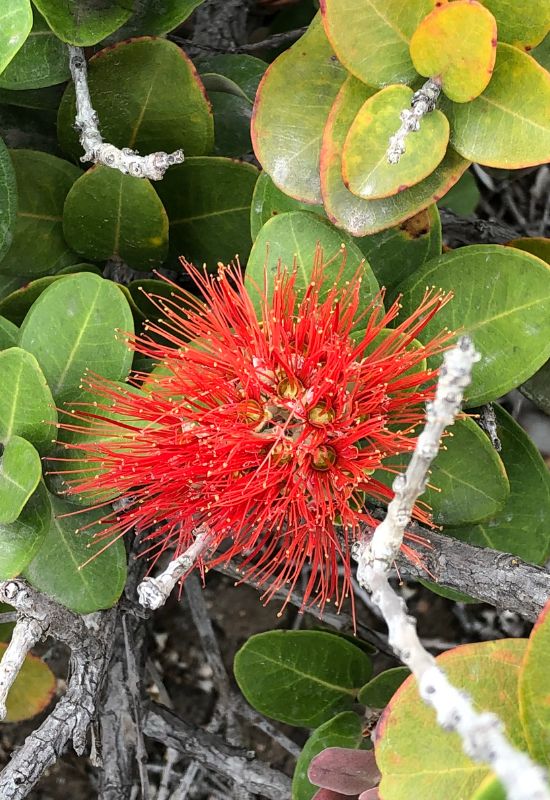
A full Hawaiian native and endemic tree with many names, one for each species, ohi ‘a lehua will also give you the unusual and exotic look you wish to import from these islands into your garden!
And it is perfect for wet land and boggy places too! A lover of high altitudes, the flowers are large and showy, like fluffy domes, mostly gracing its branches during the spring, but with bursts of color all year round!
These terminal pom-poms can be fiery red, or golden yellow, but varieties with vivid magenta and even greenish do exist as well! The foliage, evergreen, is glossy and leathery, almond shape and quite dense, with a lush but also tough appearance.
This beautiful species is very important to the People of Hawaii, especially thanks to its tough wood, used in construction, weapon making, tools and canoes, but it is also great for Nature. In fact, it is a great colonizer of lava flows.
You will need a large space to grow ohia lehua, because it can become quite a big tree; but if you do, it will surely transform your garden with its exotic foliage and bright blooms, and the flowers are medicinal as well! However, you can also grow it in containers and as a houseplant, where it will keep small (up to 3 feet tall, or 90 cm).
14: Molokai Ohaha (Brighamia rockii)
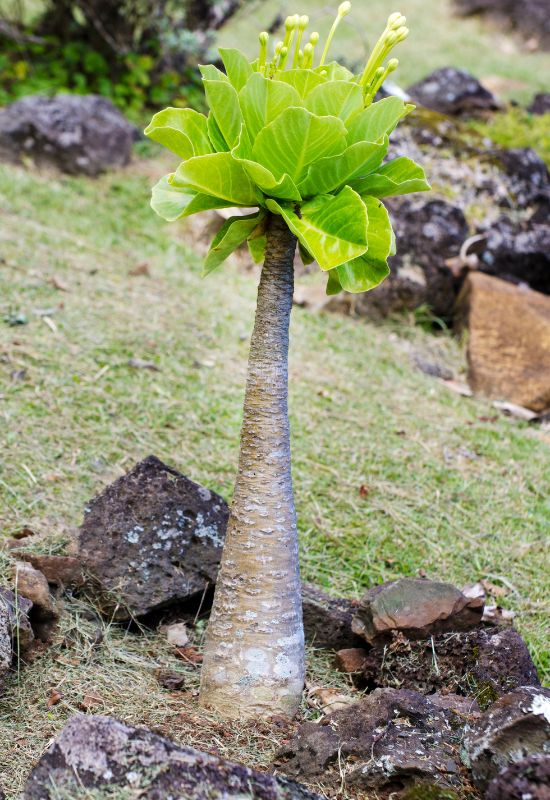
Hawaii is not just blue seas, but also tall mountains, and many of the varieties we have met come from high altitudes, from the lava rich slopes of volcanoes, and Molokai ohaha is no exception.
Native of mesic (moderately humid) forests and shrublands, this flowering perennial can grow as tall as a small tree (16 feet, or 5.0 meters)! It is very unusual because it has a plump and succulent trunk, while the leaves are broad, with a soft point and super glossy, bright green but thin.
A late bloomer, you will have to wait till fall to see its lovely floral displays. But they will come, and the whole crown will fill with small clusters of white, trumpet shaped blossoms with a star shaped mouth. It will attract pollinators too!
It is a very decorative tree like plant, and easy to propagate, but unfortunately it is mainly cultivated. In fact, it is classed as in critical status as an endangered species in the wild.
And this is a reason more why you should grow it. Either as a houseplant or as a specimen in a beautiful garden! Molokai ohaha is an extraordinary variety for flowering plant from Hawaii, with all its grace and delicate but exotic personality.
15: Haha (Cyanea angustifolia)
Coming from the same habitat as Molokai ohaha, haha, or Cyanea angustifolia is the last surprise on our list. Yes, because this variety too is really strange looking. From a distance, the clusters of flowers that grow in the shade of this plant’s dense canopy look like white bananas.
They are very long and tubular, bent and nodding, and they form a ring all around the top of the trunk like stem. But look closely and you will notice that they have a violet purple undertone, especially at the base, where it becomes strong.
And you will also see that the petals part at the end of the blossom, looking like bird feathers! What is more, they can come any time of the year, repeatedly!
The foliage has a super tropical look, with large and long, super glossy green leaves that form beautiful palm like rosettes at the very top!
Haha is yet another famous and much loved Hawaiian perennial which is now becoming more common as a cultivated plant than in the wild.
Perfect for a tropical garden, the leaves are edible when cooked, and they are used in holy ceremonies on the beautiful islands of Hawaii.
Exotic Holidays in Your Garden with Common Hawaiian Plants
There are many more varieties of typical Hawaiian plants, of course! But if you want to have that feeling of always being on holiday just stepping out of your door and into your garden, you can start with one of these ones – and you won’t regret it. So, for now, aloha!

Written By
Amber Noyes
Amber Noyes was born and raised in a suburban California town, San Mateo. She holds a master’s degree in horticulture from the University of California as well as a BS in Biology from the University of San Francisco. With experience working on an organic farm, water conservation research, farmers’ markets, and plant nursery, she understands what makes plants thrive and how we can better understand the connection between microclimate and plant health. When she’s not on the land, Amber loves informing people of new ideas/things related to gardening, especially organic gardening, houseplants, and growing plants in a small space.

